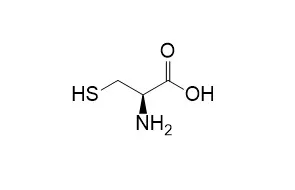| In vitro: |
| Diabetes, 2006, 55(5):1391. | | L-Cysteine Inhibits Insulin Release From the Pancreatic -Cell: Possible Involvement of Metabolic Production of Hydrogen Sulfide, a Novel Gasotransmitter[Reference: WebLink] | Hydrogen sulfide (H(2)S) was historically recognized as a toxic gas generated by natural resources. However, its enzymatic production from L-Cysteine has recently been demonstrated in mammals.
METHODS AND RESULTS:
Cystathionine beta-synthase and cystathionine gamma-lyase, both of which can produce H(2)S, were expressed in mouse pancreatic islet cells and the beta-cell line, MIN6. L-Cysteine and the H(2)S donor NaHS inhibited glucose-induced insulin release from islets and MIN6 cells. These inhibitory effects were reproduced when insulin release was stimulated by alpha-ketoisocaproate, tolbutamide, or high K+. L-Cysteine and NaHS inhibited glucose-potentiated insulin release in the copresence of diazoxide and high K+. Real-time imaging of intracellular Ca2+ concentration ([Ca2+](i)) demonstrated that both L-Cysteine and NaHS reversibly suppressed glucose-induced [Ca2+](i) oscillation in a single beta-cell without obvious changes in the mean value. These substances inhibited Ca2+ - or guanosine 5'-0-3-thiotriphosphate-induced insulin release from islets permeabilized with streptolysin-O. L-Cysteine and NaHS reduced ATP production and attenuated glucose-induced hyperpolarization of the mitochondrial membrane potential. Finally, L-Cysteine increased H(2)S content in MIN6 cells.
CONCLUSIONS:
We suggest here that L-Cysteine inhibits insulin release via multiple actions on the insulin secretory process through H(2)S production. Because the activities of H(2)S-producing enzymes and the tissue H(2)S contents are known to increase under diabetic conditions, the inhibition may participate in the deterioration of insulin release in this disease. | | Journal of Medicinal Chemistry, 1994, 37(8):1084-1098. | | Effects of L-Cysteine on the Oxidation Chemistry of Dopamine: New Reaction Pathways of Potential Relevance to Idiopathic Parkinson's Disease.[Reference: WebLink] | Oxidation of the catecholaminergic neurotransmitter dopamine (1) at physiological pH normally results in formation of black, insoluble melanin polymer.
METHODS AND RESULTS:
In this study, it is demonstrated that L-Cysteine (CySH) can divert the melanin pathway by scavenging the proximate o-quinone oxidation product of 1 to give 5-S-cysteinyldopamine (8). This cysteinyl conjugate is further oxidized in the presence of free CySH to give 7-(2-aminoethyl)-3,4-dihydro-5-hydroxy-2H- 1,4-benzothiazine-3-carboxylic acid (11) and its 6-S-cysteinyl (12), 8-S-cysteinyl (14), and 6,8-di-S-cysteinyl (16) conjugates in addition to many other unidentified compounds. 5-S-Cysteinyldopamine (8) and dihydrobenzothiazines 11, 12, 14, and 16 are all more easily oxidized than 1. With increasing molar excesses of CySH, the formation of melanin is decreased and, ultimately, completely blocked. Preliminary experiments have revealed that when injected into the brains of laboratory mice, dihydrobenzothiazine 11 and its cysteinyl conjugates 12 and 14 are lethal and evoke profound behavioral responses including hyperactivity and tremor. On the basis of these results and other recent observations, a new hypothesis has been advanced which might help explain the selective degeneration of nigrostriatal dopaminergic neurons which occurs in idiopathic Parkinson's Disease (PD). This hypothesis proposes that in response to some form of chronic brain insult, the activity of gamma-glutamyltranspeptidase is upregulated leading to an increased rate of translocation of glutathione (GSH) into the cytoplasm of dopaminergic cell bodies in the substantia nigra (SN) para compacta.
CONCLUSIONS:
The results of this in vitro study predict that such an elevated translocation of GSH into heavily pigmented dopaminergic neurons would cause a diversion of the neuromelanin pathway with consequent depigmentation of these cells and formation of 8, all of which occur in the Parkinsonian SN. The further very facile oxidation of 8 which must occur under intraneuronal conditions where 1 is autoxidized, i.e., in neuromelanin-pigmented cells, would lead to dihydrobenzothiazine 11 and its cysteinyl conjugates which could be the endotoxins responsible for the selective degeneration of dopaminergic SN neurons in PD. The ease of autoxidation of 8 is suggested to account for the low levels of this conjugate found in the degenerating and Parkinsonian SN. | | J Cardiovasc Pharmacol Ther, 2010, 15(1):53-59. | | L-cysteine stimulates hydrogen sulfide synthesis in myocardium associated with attenuation of ischemia-reperfusion injury.[Reference: WebLink] | Hydrogen sulfide (H2S) is a biological mediator produced by enzyme-regulated pathways from L-Cysteine, which is a substrate for cystathionine-γ-lyase (CSE). In myocardium, endogenously and exogenously administered H2S has been shown to protect against ischemia-reperfusion injury.
METHODS AND RESULTS:
We hypothesized that L-Cysteine exerts its protective action through stimulation of H2S production. Rat isolated hearts were Langendorff-perfused and underwent 35-minute regional ischemia and 120-minute reperfusion. L-Cysteine perfusion from 10 minutes before ischemia until 10 minutes after reperfusion limited infarct size in a concentration-dependent manner, maximal at 1 mmol/L (control 36.4% ± 2.4% vs L-Cysteine 24.3% ± 3.4%, P <.05). This protective action was attenuated by the CSE inhibitor, DL-propargylglycine (PAG) 1 mmol/L (31.4 ± 5.9%, not significant vs control) but administration of the CSE cofactor pyridoxal-5-phosphate (PLP) 50 μmol/L did not enhance the effect of L-Cysteine. Ten minutes normoxic perfusion with L-Cysteine 1 mmol/L caused a 3-fold increase in myocardial H2S concentration (0.64 ± 0.16 vs 2.01 ± 0.07 μmol/g protein, P <.01), an effect that was significantly attenuated by PAG (1.17 ± 0.15 μmol/g protein).
CONCLUSIONS:
These data provide evidence that exogenous L-Cysteine administration limits ischemia-reperfusion injury through a mechanism that appears to be at least partially dependent on H2S synthesis. |
|






 Cell. 2018 Jan 11;172(1-2):249-261.e12. doi: 10.1016/j.cell.2017.12.019.IF=36.216(2019)
Cell. 2018 Jan 11;172(1-2):249-261.e12. doi: 10.1016/j.cell.2017.12.019.IF=36.216(2019) Cell Metab. 2020 Mar 3;31(3):534-548.e5. doi: 10.1016/j.cmet.2020.01.002.IF=22.415(2019)
Cell Metab. 2020 Mar 3;31(3):534-548.e5. doi: 10.1016/j.cmet.2020.01.002.IF=22.415(2019) Mol Cell. 2017 Nov 16;68(4):673-685.e6. doi: 10.1016/j.molcel.2017.10.022.IF=14.548(2019)
Mol Cell. 2017 Nov 16;68(4):673-685.e6. doi: 10.1016/j.molcel.2017.10.022.IF=14.548(2019)